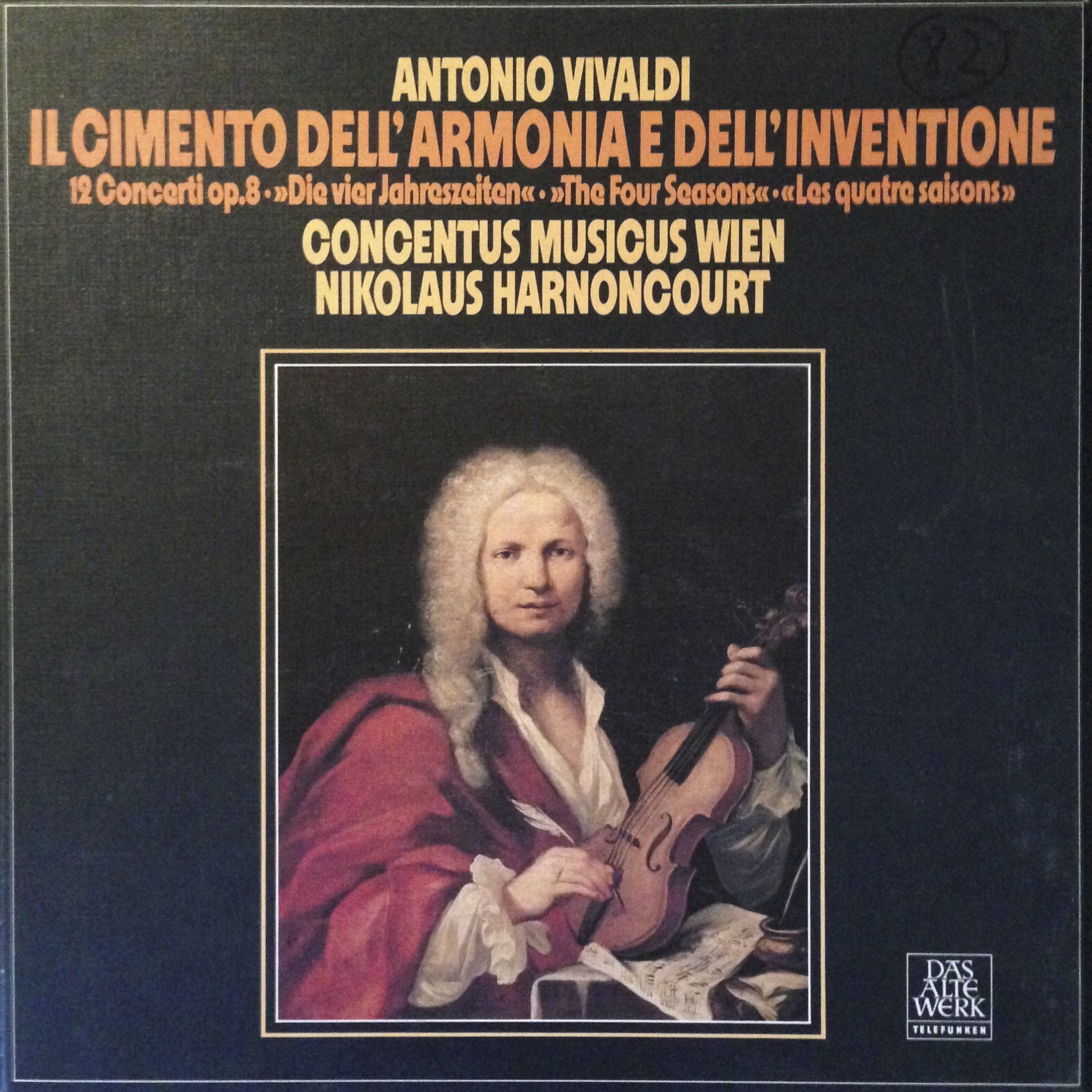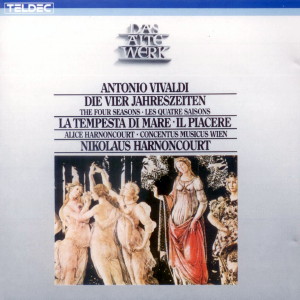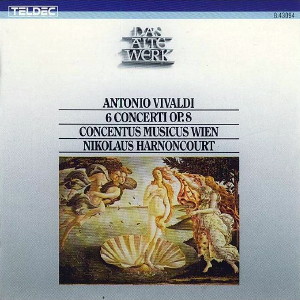 |
2 LP -
6.35386 EK - (p) 1977
|
 |
| 1 CD -
8.42985 ZK - (c) 1984 |
 |
| 1 CD -
8.43094 ZK - (c) 1984 |
|
| Antonio Vivaldi
(1678-1741) |
|
|
|
|
|
|
|
Il Cimento dell'Armonia e
dell'Inventione, Op. 8
|
|
|
|
|
|
|
|
Concerto I E-dur "La
Primavera" (F. I/22)
|
|
8' 15" |
A1 |
- Allegro
|
3' 08" |
|
|
| - Largo |
1' 53" |
|
|
| - Danza Pastorale: Allegro |
3' 14" |
|
|
| Concerto II g-moll "L'Estate"
(F. I/23) |
|
10' 51" |
A2 |
- Languidezza per il Caldo:
Allegro non molto
|
5' 41" |
|
|
- Adagio - Presto
|
2' 20" |
|
|
| - Tempo impetuoso d'Estate:
Presto |
2' 50" |
|
|
| Concerto III F-dur
"L'Autunno" (F. I/24) |
|
9' 31" |
A3 |
- Ballo e canto de'
Villanelli: Allegro
|
4' 07" |
|
|
- Dormienti ubriachi: Adagio
|
2' 38" |
|
|
- La Caccia: Allegro
|
2' 46" |
|
|
| Concerto IV f-moll
"L'Inverno" (F. I/25) |
|
7' 56" |
B1 |
- Allegro non molto
|
3' 30"
|
|
|
| - Largo |
1' 17" |
|
|
| - Allegro |
3' 09" |
|
|
| Concerto V Es-dur "La
Tempesta di Mare" (F. I/26) |
|
8' 38" |
B2 |
- Presto
|
2' 38"
|
|
|
| - Largo |
2' 30" |
|
|
- Presto
|
3' 30" |
|
|
| Concerto VI C-dur "Il
Piacere" (F. I/27) |
|
7' 31" |
B3 |
| - Allegro |
2' 43" |
|
|
| - Largo |
2' 08" |
|
|
| - Allegro |
2' 40" |
|
|
Concerto VII d-moll (F. I/28)
|
|
7' 26" |
C1 |
| - Allegro |
2' 37" |
|
|
| - Largo |
1' 51" |
|
|
| - Allegro |
2' 58" |
|
|
Concerto VIII g-moll (F.
I/16)
|
|
8' 47" |
C2 |
| - Allegro |
2' 37" |
|
|
| - Largo |
2' 14" |
|
|
| - Allegro |
3' 56" |
|
|
Concerto IX d-moll (F. I/1) *
|
|
7' 24" |
C3 |
| - Allegro |
2' 58" |
|
|
| - Largo |
1' 57" |
|
|
| - Allegro |
2' 29" |
|
|
Concerto X B-dur "La Caccia"
(F. I/29)
|
|
7' 44" |
D1 |
| - Allegro |
2' 58" |
|
|
| - Adagio |
2' 26" |
|
|
| - Allegro |
2' 20" |
|
|
Concerto XI D-dur (F. I/30)
|
|
11' 06" |
D2 |
| - Allegro |
4' 25" |
|
|
| - Largo |
1' 54" |
|
|
| - Allegro |
4' 47" |
|
|
Concerto XII C-dur (F. I/31)
*
|
|
9' 02" |
D3 |
| - Allegro |
3' 17" |
|
|
| - Largo |
2' 26" |
|
|
| - Allegro |
3' 19" |
|
|
|
|
|
|
Alice Harnoncourt,
Violino principale
|
|
Jürg Schaeftlein,
Oboe *
|
|
|
|
CONCENTUS MUSICUS WIEN (mit
Originainstrumenten)
|
|
| -
Walter Pfeiffer, Violine |
-
Alison Bury, Violine (1-4)
|
|
| -
Peter Schoberwalter, Violine |
-
Kurt Theiner, Viola |
|
| -
Wilhelm Mergl, Violine |
-
Josef de Sordi, Viola |
|
| -
Anita Mitterer, Violine |
-
Nikolaus Harnoncourt, Violoncello |
|
| -
Richard Motz, Violine |
-
Eduard Hruza, Violone |
|
| -
Ingrid Seifert, Violine |
-
Herbert Tachezi, Organo /
Cembalo |
|
-
Veronika Schmidt, Violine (5-6)
|
|
|
|
|
| Nikolaus Harnoncourt,
Leitung |
|
|
Luogo
e data di registrazione
|
| Casino Zögernitz,
Vienna (Austria) - ottobre 1976 e marzo
1977 |
|
Registrazione
live / studio
|
| studio |
Producer
/ Engineer
|
Heinrich
Weritz
|
Prima Edizione CD
|
Teldec
"Das Alte Werk" - 8.42985 ZK - (1 cd) -
53' 42" - (c) 1984 - (Concerti I-VI)
Teldec "Das Alte Werk" -
8.43094 ZK - (1 cd) - 52' 26" - (c) 1984
- (Concerti VII-XII)
|
|
Prima
Edizione LP
|
Telefunken "Das
Alte Werk" - 6.35386 EK - (2
lp) - 53'
42"
+ 52' 26" - (p) 1977
|
|
|
Notes
|
Vivaldi composed the
majority of his numerous concertos for
his own ensemble, the famous orchestra
of the Ospedale della Pietà
in Venice In 1704 he began to teach
the violin at this institution, and
from c. 1714 onwards held the
post of “maestro dei concerti". One of
several Venetian institutions
of its kind, the Ospedale was
devoted to the care of orèhaned and
abandoned gorls, who, if they showed
some aètitude, were given a musical
education. The regular performances
of concertos during services on
Sundays and holidays constituted one
of the city's principal attractions,
and travellers were quick to lavish
praise on the playing of the girls.
For example, in 1668 Peter Tostalgo
noted: "There are convents in Venice
whose inmates sing and play
the organ and various other
instrrrments so beautifully that
nowhere in the world will you find
music that is so harmonious and
sweet."
When Vivaldi included works from this
repertory in his
printed editions, he
tended to subject them to
radical revision. A comparison of the
two versions reveals that, in order to
make them commercially viable, the
printed editions usually contained a
considerable number of technical
simplifications. The Opus VIII
concertos, Il cimento dell'armonia
e dell'inventione (the title,
roughly translated, signifies “daring
experiments with harmony and
invention”), were not, it seems,
written especially for publication.
Not even the pieces that constitute
"The Four Seasons”, the
centrepiece of the collection, were
new works.
The source used in this
performance is the edition published
in Paris by Le Clerc et Me Boivin. We
consider this to be particularly
reliable in view of the fact that it
appeared immediately after the first
edition: it was carefully edited and
thus contains virtually no mistakes.
Vivaldi rendered into music the
sonnets on which “The Four Seasons"
are based, thus imparting to the work
its detailed programmatic character.
This is underlined by the fact that
letters in the parts correspond to
certain lines in the sonnets.
In the first concerto, La
primavera, the arrival of spring
is depicted in a rather theatrical
manner. The first movement, a rondo,
is a dance in the style of a bourrée
that is repeatedly interrupted by
naturalistic passages. In the slow
movement three different kinds of
tone-painting are applied
simultaneously: the calm melody of the
solo violin depicts the innocent
slumber of the shepherds, the ripieno
violins render into music the pleasant
sound of leaves rustling in the wind,
and, in a rather direct manner, the
viola imitates the barking of dogs.
The final movement with its 12/8
siciliano rhythms is a delightful
rural tableau in the style of the
baroque era peopled with dancing
shepherds and nymphs.
In L'estate (Summer),
extremely soft pianissirno dynamics
characterize breathless languor and
the heat of surnrner the slightest
movement results in complete
exhaustion. The image of oppressive
heat, which is repeated several times
in the style of a rondo (bars 52-59
and 110/116), is later recalled in L'inverno
(Winter), where it evokes the warm
scirocco wind. The cuckoo (from bar 31
onwards) is heard amidst lively
repeated semiquavers that represent a
throng of chattering birds. The
complaint of the peasant makes use of
chromaticism, a classical device of
musical rhetoric: in the slow
descending scales in the bass it
depicts resigntion, and in the solo
violin the passionate weeping and
sobbing characteristic of the south.
We hear the apprehensive boy (bars 153
and 154), and then the storm breaks
out. In the slow movement, which
depicts his attempt to overcome his
anxiety and regain his composure, the
melodic line is repeatedly interrupted
by presto passages representing
thunder, lightning and swarms of
insects, The last movement is a
musical evocation of a severe summer
thunderstorm.
L'autunno (Autumn) begins with
a merry peasants’ dancing song in
which the solo violin assumes the role
of lead singer repeating and
embellishing the music of the chorus.
Vivaldi takes great delight in
depicting a drunkard in various states
of inebriation, though this is
repeatedly interrupted by the communal
singing. The movement ends abruptly
with the dancing song with which it
began, though now, as the wine begins
to take effect, it is played faster.
In the slow movement, which evokes the
image of pleasant slumber, Vlvaldi
calls for mutes and arpeggios on the
harpsichord. The third movement is
devoted to a musical description of
the hunt.
In L'inverno (Winter) the
freezing wintry cold is depicted by
sharp bow vibrato, piercing
dissonances, and, in the first violin,
by two-finger vibrato, a kind of
microtonal trill. Particularly complex
and subtle, the slow movement shows
man happy and content in the safety of
his house, where he is warmed by the
fire and protected from the wintry
showers. The cello (molto forte)
depicts a sudden downpour, and rather
loud pizzicato in the upper strings
the water dripping down from the
eaves. Almost obscured by all this and
none the less audible, the delightful
melody of the person sitting hy the
fireside is accompanied by viola (pianissimo),
organ and bass (piano). In the
last movement Vivaldi stipulates that
the slurs in the violins (arcate
lunghe) which depict the
slippery ice must not be divided. This
indication was of some importance: in
general, long slurs merely indicated
that slurring was required, and
usually this meant short slurs, Fear
is once more depicted by intensive bow
vibrato After the drama on the ice,
which ends with a fall and the ice
breaking up, we hear the warm scirocco
wind leaving its winter quarters (bars
102-120). Here Vivaldi makes use of
the image of oppressive heat from L'estate
(Summer), and this reminds us of the
cyclic pattern of the whole work.
La tempesta di mare depicts the
stormy sea and waves that roll in from
afar, syncopated breakers, as it were,
whose whirling spume and foaming
crests (from bar 53 onwards) tower
ever higher and closer (from bar 61
onwards), The description obviously
continues in the second rrrovement.
There is a moment of tranquillity, and
the waves begin to subside. However,
quiet undulation continues to be
clearly audible in the unison triads
of the tutti. In the third movement
bizarre general pauses that retard the
flow of the music and unusual and
cleverly concealed changes of metre
reflect the musical daring announced
in the collective title.
At the beginning of Il piacere
rejoicing and exultation are portrayed
by means of syncopations and
embellished leaps of a fifth. The slow
movement with its 12/8 siciliano
rhythm is evidently a depiction of
rural life: in the baroque era
pastoral scenes were always symbolic
of harmony and of pure and innocent
joy. However, in the third movement
the rejoicing has acquired a comical
and somewhat derisory character. In
the tutti large leaps of an octave, a
tenth, a twelfth and more lead to
suspensions, striking and mocking
gestures that, in the form of a
dialogue, stand in marked contrast to
the solo part.
The structure of Concerto No. 7 is
quite different. The same material is
employed in the tutti and solo
passages, and thus the soloist merely
comments on the motto theme first
played by the orchestra. The movement
depicts and contrasts numerous
affections of a passionate, tender,
active and passive kind. In the slow
movement the soloist embelhshes the
repeats in an improvisatory manner to
the accompagniment of arpeggios played
alternately by the first and second
violins. The last movement is rather
witty and sometines verges on
slapstick.
The influence of the commedia
dell'arte is clearly apparent in
Concerto No. 8. The solo violin is
given motifs of its own (which are
distinct from those of the tutti
passages), though these themes are
frequently incomplete. The initial
motif finally continues on its own.
Although the tutti passages are based
on the material of the first tutti,
they are always varied in a witty
manner. The second movement, which is
in the style of sixteenth-century
vocal polyphony; comes an something of
a surprise. A secular movement is
followed by a sacred one, just at the
carnival season is followed by Lent
(which is hinted at by sorrowful
chromaticism in the bass). The finale
is a whirling popular dance with
bizarre chords and rather eccentric
violin solos.
In Concerto No. 9 at stubborn
syncopated motif supported by the
quavers of et walking bass is answered
and challanged by two lamento bars,
which consist of a rhapsodic and
sorrowful chromatic motif. The first
solo passage is a free adaptation of
the syncopated motif of the opening
tutti. The tutti passages that
separate the cheerful and witty solo
sections always end with the lamento.
The slow movement, which is for oboe
and basso continuo, continues to dwell
on the sad and elegiac mood of the
first movement. The finale, as in so
many of Vivaldi's concertos. is based
on a lively popular dance. The unusual
rhythm (the fact that 3/2 and 2/2
alternate in an irregular manner
becomes apparent from the metrical
structure, and not from the notation),
the voice leading, and the soloist's
embellishments are all reminiscent of
oriental music. Venice maintained
close links with the Countries of the
eastern Mediterranean for centuries,
and thus it is not surprising that
Venetian composers were often
influenced by Mediterranean folk
music.
The vigorous 3/4 thermes which imitate
the horn in the next concerto. La
caccia, describe jolly huntsmen
riding out into the countryside in
pursuit of their quarry. The hunters
and the hunted are depicted by the
solo violin's triplet runs and horn
motifs. This game is repeated four
times (though on the second occasion
the animal is cornered and killed).
The second movement does not seem to
have anything to do with this subject,
though its striking rests impart a
special and almost hesitant character
to the musical dialogue. The last
movement again depicts a hunt. As in
the first movement, there are several
episodes (which are separated by tutti
passages) and these seem to depict the
reactions of various animals. The
first shows one of them simply running
away; and in the second another one
leaps up and then crawls along. The
large leaps in the third episode
culminate in an animal's attempt to
escape, and its melancholy end.
Concerto no. 11, which begins with a
four-part fugato, is a brilliant
compendium of contemporary stylistic
possibilities The contrapuntal
introduction is interrupted once by a
motif that whirls along nimbly in the
style of Neapolitan folk music for
mandolins, and then by sentimental
syncopations. In this concerto Vivaldi
revels in some impressionist sounds
which only becorrre audible in
performance and cannot be deduced from
the individual parts. The slow
movement is also based on such magical
images: with the help of bow vibrato
the upper strings create a texture
from which the solo violin emerges
like an upper partial that becomes
more and more audible. The finale
begins with a fugato, as in the first
movement; and the first tutti ends
abruptly with an incisive dotted motif
repeated four times and some soft
scales. With the exception of the
fugato sections, this movement is
another example of the oriental
influence that was omnipresent in
Venice.
The first movement of Concerto No. 12
is unmistakably rustic in character.
Vivaldi seems to have been inspired to
write this very rural piece by the
sound of the oboe, and by a plethora
of ideas derived from folk music. The
motifs of the solo oboe, which are
quite different from those of the
strings, are cantabile and elegant, so
that we seem to be hearing a
conversation between a master and his
servant. In the slow section the
repeats are embellished in an
improvisatory rnanner. The last
movement is once again in the style of
a rustic dance.
Nikolaus
Harnoncort
Translation:
Alfred Clayton
|
|
Nikolaus
Harnoncourt (1929-2016)
|

|

|
|